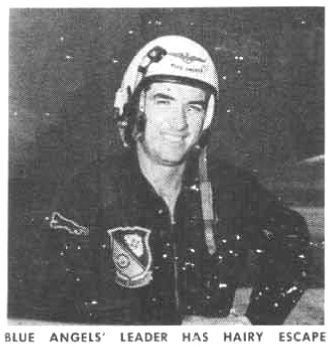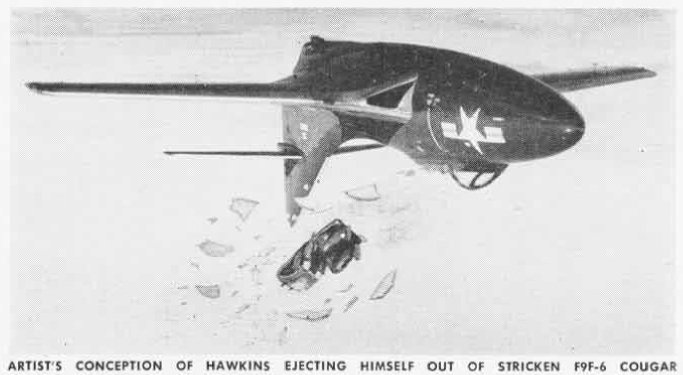|
N AVAL AVIATION NEWS |
|||||
|
BLUE ANGEL EJECTS AT HIGH SPEED Published in the October 1953 issue of Naval Aviation News |
|||||
|
How would you like to break the sonic barrier with your bare hands, |
|||||
|
|
The "Chief Angel" of the Navy’s famous Blue Angels exhibition flight team, LCdr. Authur Ray Hawkins, has set what may be a new "speed and altitude" record for the bailout league. Flying a new F9F-6 en route from Grumman Aircraft plant to Corpus Christi, home of the Blue Angels, Hawkins’ Cougar suffered a malfunction in the longitudinal controls. He was flying with a wingman from his team at about 40,000 feet. The Angels were switching for F9F-5’s to F9F-6’s. When the trouble developed, the swept-wing jet nosed downward despite his efforts to pull out of the dive. |
||||
|
At 35O he popped his air breaks in an attempt to freak the screaming dive, went into a vertical attitude, then inverted. Hawkins began to "red out" from the outside loop flight attitude. Unable to reach the stick or pre-ejection lever on the plane’s console, the three-time Navy Cross winner realized he had to get out of the plane but soon. Reaching to the side of the headrest of his seat, he pulled the manual release to remove the safety pin from the catapult so the seat could be fired without jettisoning the canopy. Since he could not pull the pre-ejection lever, he was faced with blowing himself through the Plexiglas. Although the Navy has experimented with ejecting dummies through the canopy of a jet plane, Hawkins is believed the first Navy pilot to use this method of emergency exit. Since he was "floating" inside the cockpit upside down before he ejected, he probably was not in the correct position when he pulled the ejection curtain and fired the cartridge. SEAT GIVES A JOLT He was not wearing a pararaft, so when the seat came up and met him he received a slight "charley horse" in his legs from the jolt. He sustained only two minor cuts from the shattered Plexiglas as he emerged from the cockpit into the rock-wall slipstream. Hawkins told BuAer representative he felt no great shock when the air hit him, although it ripped off his anti-buffet helmet, sunglasses and oxygen mask. He did not remember releasing the face curtain of his seat. Hawkins said he believed he ejected himself from the seat about 32,000 feet altitude. His wingman thought it was neared 25,000 feet. That difference in altitude would mean the difference between about 780 miles an hour true air speed and 680 miles an hour. The last he remembered was his gauges showed 400 knots indicated airspeed. So there was the head Blue Angel, flat on his back at 25,000 to 32,000 feet, in 20O below zero temperature, in a light flight suit, with no oxygen at an altitude far above where pilots are suppose to need it to live. He grabbed for his ripcord but was unable to locate it at first in his semiconscious condition. He believes his parachute finally opened at about 29,000 feet, but by that time the rapid deceleration had slowed him down so the chute did not rip upon opening. He tried to slip his parachute by pulling on the risers to increase his rate of fall but was too weak. He lost consciousness for short periods two or three times, possibly from lack of oxygen. While he was descending, the F9F-6 kept in its death dive and crashed near Pickens, Miss., with the wingman following it down then zooming back up to see how Hawkins was doing. Hawkins’ parachute was spotted in the air by a farmer, Arthur Edwards, who was driving a truck. He picked up the pilot and took him to NAS Memphis. F9F’s TO BE CHANGED The pilot probably owes his life to the fact he was flying a new Cougar jet with the safety pin beside the seat headrest, which he could pull when unable to reach the pre-ejection lever. This is now being incorporated in all production F9F’s. BuAer is issuing a service bulletin to put this feature on all ejection seats where it is feasible to fire them through the plexiglas canopy if it will not jettison. Whether Hawkins ejected at a speed of 780 or 680 miles an hour, he still wins the honors for being the "high speed champion" of the Navy. Previous record speed was believed to be about 600 mph when LCdr. J. L. "Pappy" Fruin ejected from his crippled F2H at 20,000 feet over South Carolina in 1949. Fruin is now attached to the ejection seat section of BuAer Airborne Equipment division. |
|||||
|
|
|||||
|
Link to the Article for the Post Magazine in the History section I HAD TO BAIL OUT AT SUPERSONIC SPEED by Lt. Cmdr. Ray Hawkins, USN as originally written in 1954 for Post Magazine |
|||||


